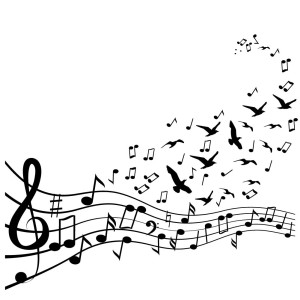 One of my goals for this site has been to educate people about music itself, to help spread the knowledge that I’ve picked up over the years of learning from various music teachers, other musicians, books I’ve read, and my own experience as a musician and composer. Early on, all I ever wanted to be was a good guitar player, but one of my first guitar teachers drilled into my head that every musician should understand music itself, not just how to play their instrument. His argument was that a solid understanding of music theory would empower you to play in almost any style you like, in any key you like, and make sense of what other musicians were doing. I took his advice to heart and tried to learn as much as I could about music over the years. Every time I learned a new song or new guitar lick that I liked, I tried to analyze it on musical terms to find out why it worked. More often than not, there was usually something that pointed back to a topic I’d learned in my music studies that explained why something worked. I’ve always wanted to pass along those bits of information that helped my understanding so that I may inspire other musicians in the same way as I have been. I just wasn’t sure how to do this brain dump until now.
One of my goals for this site has been to educate people about music itself, to help spread the knowledge that I’ve picked up over the years of learning from various music teachers, other musicians, books I’ve read, and my own experience as a musician and composer. Early on, all I ever wanted to be was a good guitar player, but one of my first guitar teachers drilled into my head that every musician should understand music itself, not just how to play their instrument. His argument was that a solid understanding of music theory would empower you to play in almost any style you like, in any key you like, and make sense of what other musicians were doing. I took his advice to heart and tried to learn as much as I could about music over the years. Every time I learned a new song or new guitar lick that I liked, I tried to analyze it on musical terms to find out why it worked. More often than not, there was usually something that pointed back to a topic I’d learned in my music studies that explained why something worked. I’ve always wanted to pass along those bits of information that helped my understanding so that I may inspire other musicians in the same way as I have been. I just wasn’t sure how to do this brain dump until now.
First a disclaimer:
The information I’m providing here is not a substitute for a complete course in music theory. There are plenty of books and resources online to obtain more complete coverage of music theory. Instead, I will focus my articles on those topics that I use most often songwriting and soloing while leaving out the topics that are more focused on the aspects of music notation and sight reading, which you would cover in any music theory course. As a general emphasis, I’ll focus more on the topics pertaining to an understanding of harmony rather than rhythm and notation.
Music theory can be an intimidating subject to a lot people because the material itself can be a little dry and technical in nature. I will try to make my explanations more interesting so that it doesn’t read like a text book, but more like a straightforward explanation of how things work (that’s my goal anyway). I’ll also try to explain these concepts by giving lots of musical examples that most people will be familiar with.
When I took music theory courses in college, one of my criticisms was that the musical examples used in the class were often taken from classical works that I wasn’t familiar with. I always wondered why someone didn’t present the material in a more straightforward way using examples found in music that was written in the past century that most people would have heard in popular music, TV, radio, Broadway shows, etc.
What is Music Theory and Why Study It?
Think of music theory as an explanation of the structure of western music in the same way that science and physics explains the structure and laws of the natural world. By “western music”, I don’t mean music played by guys in cowboy hats and rind-stone suits with names like H ank
ank , Merle, and Buck. In this context western music refers to music that has its roots in Europe (based on the use of an equally-tempered 12-tone system, or 12 pitches per octave) as compared to music originating in Asia, the Middle East, and India that use completely different tonal system (use of micro tones, etc) that are not normally used in western music.
, Merle, and Buck. In this context western music refers to music that has its roots in Europe (based on the use of an equally-tempered 12-tone system, or 12 pitches per octave) as compared to music originating in Asia, the Middle East, and India that use completely different tonal system (use of micro tones, etc) that are not normally used in western music.
In the same way that you can appreciate the natural world without having a deep understanding of the laws of physics and biology, your brain is already familiar with the musical structure explained by music theory from exposure to the huge amount of music that you encounter everyday that you’re not even conscious of (music from the web, music used in TV ads, underscore music in film, music that is part of your video games or phone apps) . Your brain responds to this structure in an emotional way, even though you may not be conscious of the underlying structure of the music itself. This is an example of the universal language of music. It’s a language of feeling and emotion. Music theory only tries to explain these commonly-used structures and set of guidelines (or rules) for what has been used by composers in the past to create various sounds you hear every day in music. Some people tend to understand these structures instinctively, and may not even be aware of it when they write songs. I look to musicians such as Paul McCartney and John Lennon as examples of people who seem to have this innate understanding. Their songs make a lot of sense musically, even though they may not have ever studied music theory or harmony in their development as song writers. However, when you read about Paul McCartney’s upbringing you find that his father played piano at home and was a huge fan of Broadway show music. Paul’s brain was probably infused with a lot of good examples of common chord progressions, song structures, and melodies that he heard so often as a kid, leaving an indelible impact on his musical instincts as a song writer. In fact you can hear some of this show-music influence in some of his songs such like “When I’m 64” and “Your Mother Should Know”.
The music you listen to affects your musical instincts
Your ear will often tell you when things work (or not) even if your brain is not aware of the structure, only because your brain is already used to hearing these patterns in other music that you have been exposed to. The lesson here is to listen to great music as often as you can and absorb it! Even if you don’t understand it all, your brain is taking it all in and developing your internal reference points about “what works” in song writing. But don’t stop there, expose your kids to as much great music as often as you can while they are growing up. Expose them to everything: Jazz, Blues, Classic Rock, show tunes, orchestral music, Country, Bluegrass … everything from Abba to Zappa. You never know if you may have a young Paul Simon or Carol King in your midst, absorbing all of that music like a sponge.
One of the most powerful concepts of music theory is gaining an understanding of harmony
Harmony in this sense refers to the way various notes sound together, not limited only to vocal harmony but any sound source, whether those notes are played on a chordal instrument (such as a piano or guitar) or played by more than one instrument (such as a group of violins, horns, or a guitar and bass playing together). When more than one note is sounding at a time, you have harmony.  As I will explain, various notes sounded together will create different harmony depending upon how far apart they are in pitch. Some combination of pitches create pleasant, stable sounds to your ear, and some are tense and unstable, depending on this distance between the notes. Composers use these pleasant (consonance) and tense (dissonance) sounds to create tension and release in their music. This is part of the way emotion is conveyed through music, using this interplay of tension and release. If all music consisted only of pleasant, consonant harmonies and no dissonance, then it would be like watching a movie where there is no conflict, sadness, or struggle, and only happiness from beginning to end. (Although you may want this effect if you’re writing music to be used for relaxation therapy). The opposite is also true. A song with dissonance from beginning to end creates a feeling of uneasiness. It’s no accident that alarm systems take advantage of dissonant harmony when they design the combination of pitches for an alarm sound. They want to create a feeling of uneasiness alertness.
As I will explain, various notes sounded together will create different harmony depending upon how far apart they are in pitch. Some combination of pitches create pleasant, stable sounds to your ear, and some are tense and unstable, depending on this distance between the notes. Composers use these pleasant (consonance) and tense (dissonance) sounds to create tension and release in their music. This is part of the way emotion is conveyed through music, using this interplay of tension and release. If all music consisted only of pleasant, consonant harmonies and no dissonance, then it would be like watching a movie where there is no conflict, sadness, or struggle, and only happiness from beginning to end. (Although you may want this effect if you’re writing music to be used for relaxation therapy). The opposite is also true. A song with dissonance from beginning to end creates a feeling of uneasiness. It’s no accident that alarm systems take advantage of dissonant harmony when they design the combination of pitches for an alarm sound. They want to create a feeling of uneasiness alertness.
Although having a solid understanding of harmony won’t make you a more creative composer, it does provide you with a set of tools to draw from for helping you along the way to refining your inspired ideas into something that is more complete. It also helps you to explore options as you find yourself working through ideas in the songwriting process. It is also an invaluable asset in the arranging and production process as you work through musical parts that need to sound good together, supporting the harmonic structure of the song itself. As an example, check out this version of Elenor Rigby as it likely sounded when Paul McCartney first wrote the basic structure of the tune (although his original version was on piano, and John wrote the lyrics), where you will hear the basic form of the song but nothing more. By contrast, later in the video you hear the full version of the song with the string quartet accompaniment that George Martin brought to it. You’re hearing George Martin’s skill in applying his understanding of harmony and orchestration to fully realize the potential of the underlying harmony in the song.
The string accompaniment is part of the magic that made this song so amazing. This is why we want to learn about harmony!
In this series of upcoming articles, I hope to answer some of the following questions (I’ll add more to this list as I cover more topics):
- Why study music theory at all? (covered in this article)
- What are intervals and how are they used in music?
- What are key signatures?
- What is a major scale?
- What is a minor scale?
- Where do chords come from and how do you know which notes are contained in a given chord?
- What are chord progressions and how are they used in composing?
- What are chord inversions?
- What are chord voicings?
- How can you apply “Jazzier” sounding chords in your song writing?
- What are chord substitutions and how do you use them?
- How do you come up with more interesting bass lines, or create “walking” bass lines for a given chord progression?
- What is an arpeggios and how are they used in music?
- What are modes and how do you apply them in your songwriting?
